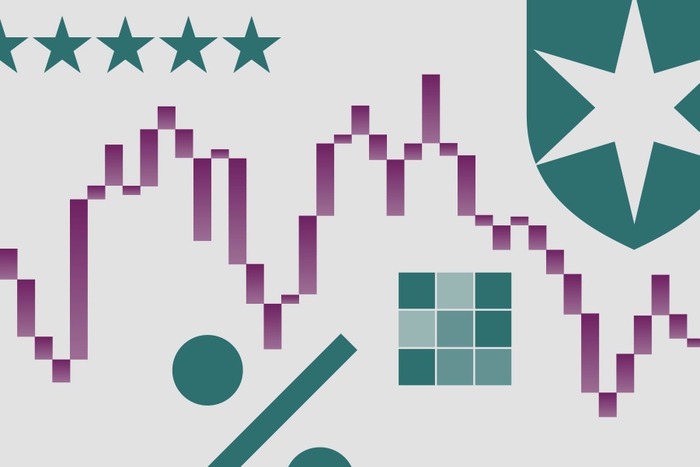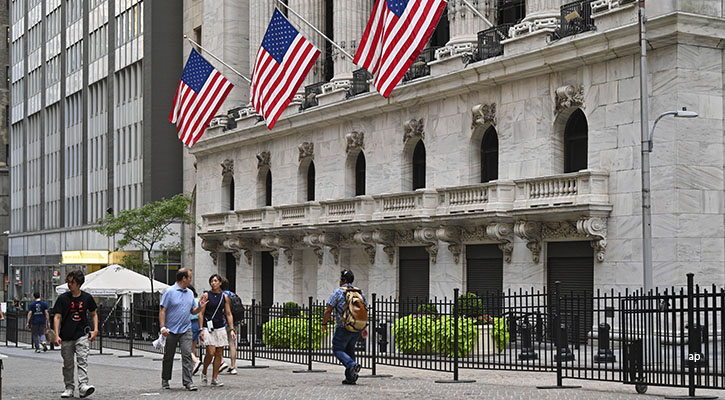In part 1 of this article, we had a look at how factors are cyclical. In part 2, we take a look at the common these in factors.
Ch-Ch-Ch-Ch-Changes
This was a year marked by some swift and sizable changes in factor leadership. There were some common themes among them. Each is a reminder of what I believe to be the core tenets of successful factor investing: discipline and diversification.
Exhibits 3, 4, and 5 are relative wealth charts. They plot the relative performance of the growth of an invest-ment in one fund versus another over time. When the line slopes upward, the fund in the numerator is outperforming the fund in the denominator. For example, in Exhibit 3, you’ll notice the line spikes upward beginning at the end of October 2016. During this span Vanguard Value ETF (VTV) outperformed Vanguard Growth ETF (VUG). When the line slopes downward, the opposite is true. And when the line is trending flat, the two funds are neck and neck. This allows us to readily identify trends in the relative performance of different factors.
.png)
.png)
.png)
Value vs. Growth
VTV has lagged VUG for over a decade. As I discussed in a previous article “Value Investors are Vexed”, this has tried the patience of even some of the most faithful value investors. This year, value made a comeback. For the year to date through Nov. 30, VTV outperformed VUG by nearly 9 percentage points. This isn’t magic, but classic value investing in action. The largest contributors to VTV’s performance through the first 11 months of the year were stocks in the GICS financials, industrials, and energy sectors. These stocks entered the year battered and bruised and took some additional lumps early in the year. Fast-forward to the end of November, and these three sectors are the best performers within the S&P 500. At the risk of stating the obvious, value works best when there are values in the market.
Sall vs. Large
Small-cap stocks, represented here by iShares S&P Small-Cap ETF (IJR), had spent the better part of the past three years lagging their large-cap counterparts, represented here by iShares Core S&P 500 ETF (IVV). This has reversed in a big way late into 2016. In the month of November, IJR outperformed IVV by nearly 9 percentage points. This was driven in large part by a post-election rally in small-cap technology, industrials, and materials firms. It is too soon to tell whether this event-driven boost in small-cap stocks is overdone, but it is further evidence of the fickle nature of factors’ performance.
High Beta vs. Low Volatility
Low-volatility stocks have been market darlings in recent years as investors have flocked to relatively safer equities in search of income and the prospect of a smoother ride for the equity sleeves of their portfolios. Higher-beta stocks, represented here by PowerShares S&P 500 High Beta ETF (SPHB) have lagged their less risky peers, represented here by PowerShares S&P 500 Low Volatility ETF (SPLV), for the past three years and endured a particularly difficult stretch that began in the middle of 2015. But beginning earlier this year, some of the markets most sensitive names have bounced back. SPHB out-performed SPLV by nearly 18 percentage points for the year to date through November. This owes chiefly to SPHB’s large allocation to energy stocks—which are absent from SPLV’s portfolio.
Key Take-Aways
1. Factors have cycles. They will experience stretches of out- and underperformance relative to other factors as well as the broader market. No two cycles are identical. These periods can be spurred by different fundamentals and will vary in length. Oftentimes, they will lag for a duration that is many multiples the duration of an average investor’s patience.
2. The payoff to any given factor may be concentrated in a short period of time. Think of value following the bursting of the tech bubble. Predicting these spurts is impossible.
3. Factors’ cyclicality is also part of why they exist. Investor behavior is a key driver of factors’ ups and downs.
4. Timing is a bad idea. It is all but impossible to do well, and the payoff of implementing a successful timing strategy isn’t likely great enough to justify the risk.
5. As is virtually always the case, diversification is probably your best bet. Combining a number of single-factor funds or investing in a multifactor fund could diminish the likelihood of bad behavior and thus increase the odds that you’ll put factors to good use.

















